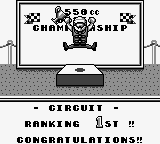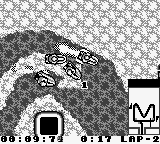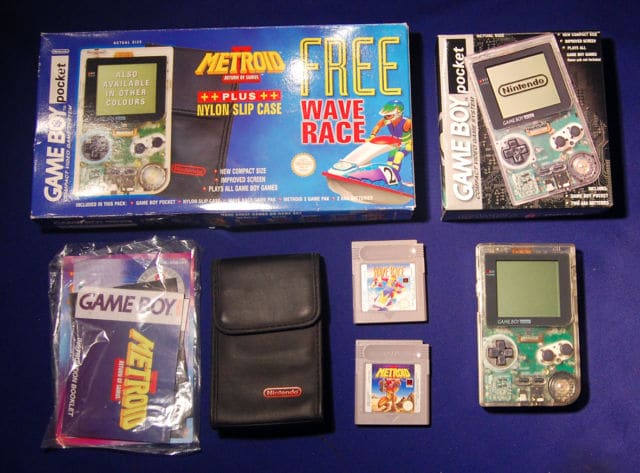Wave Race

- North American release in July 1992
- European release in June 1997
- North American release in 1997
- Never released in Japan
- Developed by Pax Softonica
The Wunderkind Is Here

In 1992, Shigeru Miyamoto made his first Game Boy game with Wave Race. This is important, not because Wave Race is this extraordinary game; it’s actually quite ordinary. It’s important because it’s the only time Miyamoto joined a party late. Outside of Wave Race, Miyamoto has been front and centre on day one with a marquee title that helps define a new system (Donkey Kong on Famicom, Super Mario World, Super Mario 64, Super Mario Advance, Luigi’s Mansion). For the other exception, the Virtual Boy, he stayed completely away from that console and so never joined the party at all, and he described the Virtual Boy as a toy, not a console.
With Wave Race, Miyamoto was riding in the wake of other developers instead of making the waves himself. It is a unique opportunity to see how Miyamoto works when he’s not directly collaborating with the hardware designers during the development of a console. That undeniably makes Wave Race essential.
Conjecture

Why did Miyamoto start designing games for the Game Boy so late? We have no exact idea, but looking at where the Game Boy stood around 1992, we can mount a reasonable theory. With Yokoi’s R&D1 hard at work on project VR32, which will ultimately become the Virtual Boy, their output on Game Boy was reduced to one game a year. Hiroshi Yamauchi, Nintendo’s fearless CEO, probably decided that this was not enough games to sustain the momentum of their most successful system. Miyamoto was then asked to develop games for it, with a third-party company assigned to work with him: Pax Softnica. This is the same structure that was used for the development of Kid Icarus: Of Myths and Monsters, with one Nintendo employee, Masafumi Sakashita, supported by employees from a contracted company. Does Miyamoto’s collaborative effort compare favourably to Sakashita’s efforts? Yes, but both games do vastly different things.
Retrogaming in 1992

The most important difference between Kid Icarus and Wave Race is that Miyamoto made a backwards-looking title. The most interesting 1992 Game Boy titles are more involved experiences than this jet ski racing game. It feels more like a 1990 Game Boy title. I would have expected something with far more configurability, or with a great personality. Super Mario Kart, in a sense. Instead, the game is limited in a way that makes me feel like Miyamoto was aping R&D1’s style. At first glance, Wave Race looks like a different interpretation of F1 Race, the inaugural four-player adapter title. You don’t see any charming interactions, with the game sticking close to its subject matter. The game has a save feature, but only to keep track of your time records and to tell which engine class championships you have unlocked. With the championships forcing you to redo all the races of the previous classes, this makes the game more repetitive than it ought to. Think about it, this means that whatever selection you make, you will always have to start with the same race. It’s as if a Mario Kart championship always started with the same exact race. There are two types of circuits, however, which greatly helps to shake things up. You have a racing circuit, but also a point-chasing game, where you have to go through gates to gather points. The caveat is that each gate only gives point to the first player to go through. This means you have to chase different routes than your adversaries. It’s neat, and I’m wondering if this is a racing style that exists in real life.
All in all, the game is simple, but there is that element of Miyamoto magic present, this tireless focus on core gameplay that I love so much about him.
The Miyamoto Touch

I’ve previously discussed racing games with other perspectives, but this is our first top-down racing game. Wave Race uses a top-down perspective with directional, instead of tank, controls. It’s very well done, with everything you need to help you succeed despite the limited point of view and constant scrolling action. You have a map with dots for the racers, helpful ranking numbers right next to your character so you don’t have to spend a moment looking away from the centre of the screen. It’s a busy game for the slow screen of the original Game Boy, but it does not become impossible to see; you can always see what’s happening. It does that by using very clean, repeating patterns for the water you race on. Even though things are blurry, the repeating pattern helps your brain make sense of the blur.
Racing on water means you can’t brake; the game uses this simple fact as the core gameplay hook of the whole game. Can you manage tight turns without brakes? The manual informs you that the best turning method is to let go of the gas as you enter the turn, use momentum to rotate your vehicle and then hit the boost right as you exit the turn to sharpen your angle. It’s fun to do. You also have to be careful to make sure you have enough boosting power for each turn, since it regenerates very slowly.
I like the conceit of the slowly regenerating boost. It starts every race empty, and you really have to manage it. I think it’s there because your throttle is digital, and that meant that there’s no way to represent a rev-up during a turn to push your jet ski closer to the turn. By using a boost that you hit with the second button, you can mimic this precise throttling action. For a game with such a heavy focus on precise arcade-style racing, power-ups would be an unconventional addition. Surprisingly, the game has two special items, represented by animals, that give you a temporary special power. But those upgrades, coupled with the funky hazards peppered throughout the race, are to me an expression of Miyamoto’s design philosophy. They make the game interesting at all times. You are never simply running in a direction, doing nothing but pressing a button. You are constantly distracted, pushed and pulled in different directions. It’s never boring.
The final element that keeps the game exciting at all times is the AI. It is reasonably good. They ram you when you get too close, they step in front of you to deny passage, they steal the special items, and they pull ahead of you and do not wait around if you make too many mistakes. I know they’re controlled by very simple logic, but time and effort were clearly spent to make them interesting. I can clearly see that Miyamoto sweat over their reactions.
Conclusion
Until the reorganization of Nintendo divisions in 2003, Miyamoto was in the trenches developing games through the management of his own division, Nintendo EAD. Sweating over AI racers in Game Boy games. After 2003, Miyamoto took a gradual step away from managing a team, and he became this kind of internal consultant, able to provide input to his cadre of protégés who are themselves responsible for the overall management of all of Nintendo’s teams. This has made him the most senior artisan in the company, supporting every single project at the company with his insights. When Nintendo CEO Satoru Iwata suddenly died in 2015, Miyamoto even rose to the position of interim co-CEO with Genyo Takeda during the search for a replacement. The father of Mario oversaw the whole gosh darn company for years. Miyamoto is without any doubt the person with the largest impact on the company.
With Wave Race, we have this artifact from a time where Nintendo’s most important executive wasn’t supervising the whole company’s output, and instead had to design a small game for a console he didn’t help to create. What an interesting legacy for such a low-key game. Sold in the United Kingdom, this set included a Game Boy Pocket and two games, Wave Race and Metroid II: Return of Samus.
Sold in the United Kingdom, this set included a Game Boy Pocket and two games, Wave Race and Metroid II: Return of Samus.
This article was first published on the .
This article was last modified on the .